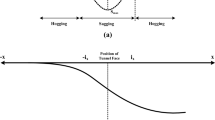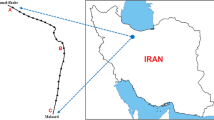Abstract
Ground surface movement due to tunnelling in urban areas imposes strains to the adjacent buildings through distortion and rotation, and may consequently cause structural damage. The methods of building damage estimation are generally based on a two-stage procedure in which ground movement in the greenfield condition is estimated empirically, and then, a separate method based on structural mechanic principles is used to assess the damage. This paper predicts the building damage based on a model obtained from artificial neural network and a particle swarm optimization algorithm. To develop the model, the input and output parameters were collected from Line No. 2 of the Karaj Urban Railway Project in Iran. Accordingly, two case studies of damaged buildings were used to assess the ability of this model to predict the damage. Comparison with the measured data indicated that the model achieved the satisfactory results.










Similar content being viewed by others
References
Skempton AW, MacDonald DH (1956) The allowable settlement of buildings. Proc Inst Civ Eng 5(3):727–768
Charles JA, Skinner HD (2004) Settlement and tilt of low-rise buildings. Geotechn Eng 157:65–75
Burland JB, Wroth CP (1974) Settlement of buildings and associated damage. In: Proc conference settlement of structures. Pentech Press, London, pp 611–654
Boscardin MD, Cording JC (1989) Response to excavation-induced settlement. J Geotech Eng 115(1):1–21
Boone SJ (1996) Ground-movement-related building damage. J Geotech Eng 122(11):886–896
Boone SJ, Westland J, Nusink R (1999) Comparative evaluation of building responses to an adjacent braced excavation. Can Geotech J 36:210–223
Finno RJ, Voss FT, Rossow E, Tanner Blackburn J (2005) Evaluating damage potential in buildings affected by excavations. J Geotech Geoenviron Eng 131:1199–1210
Netzel H (2009) Building response due to ground movements. IOS Press, Amsterdam
Namazi E, Mohamad H (2013) Potential damage assessment in buildings undergoing tilt. Proc Inst Civil Eng Geotech Eng 166(4):365–375
Namazi E, Mohamad H (2013) Assessment of building damage induced by three-dimensional ground movements. J Geotech Geoenviron Eng 139(4):608–618. https://doi.org/10.1061/(ASCE)GT.1943-5606.0000822
Potts DM, Addenbrooke TI (1997) A structure’s influence on tunnelling-induced ground movements. Proc ICE-Geotech Eng 125(2):109–125
Son M, Cording EJ (2005) Estimation of building damage due to excavation-induced ground movements. J Geotech Geoenviron Eng 131:162–177
Son M, Cording EJ (2007) Evaluation of building stiffness for building response analysis to excavation-induced ground movements. J Geotech Geoenviron Eng 133:995–1002
Franzius JN, Potts DM, Burland JB (2006) The response of the surface structure to tunnel construction. Proc ICE Geotech Eng 159(1): 3–17
Dimmock PS, Mair RJ (2008) Effect of building stiffness on tunnelling-induced ground movement. Tunn Undergr Space Technol 23(4):438–450
Farrell RP, Mair RJ, Sciotti A, Pigorini A, Ricci M (2012) The response of buildings to tunnelling: a case study. Geotechnical aspects of underground construction in soft ground. In: Proceedings of the 7th international symposium on geotechnical aspects of underground construction in soft ground, pp 877–885
Sharma LK, Vishal V, Singh TN (2017) Predicting CO2 permeability of bituminous coal using statistical and adaptive neuro-fuzzy analysis. J Nat Gas Sci Eng 42:216–225
Sharma LK, Vishal V, Singh TN (2017) Developing novel models using neural networks and fuzzy systems for the prediction of strength of rocks from key geomechanical properties. Measurement 102:158–169
Singh R, Umrao RK, Ahmad M, Ansari MK, Sharma LK, Singh TN (2017) Prediction of geomechanical parameters using soft computing and multiple regression approach. Measurement 99:108–119
Hasanipanah M, Armaghani DJ, Amnieh HB, Majid MZA, Tahir MM (2017) Application of PSO to develop a powerful equation for prediction of flyrock due to blasting. Neural Comput Appl 28(1):1043–1050
Hasanipanah M, Amnieh HB, Arab H, Zamzam MS (2016) Feasibility of PSO-ANFIS model to estimate rock fragmentation produced by mine blasting. Neural Comput Appl 1–10
Taheri K, Hasanipanah M, Golzar SB, Majid MZA (2017) A hybrid artificial bee colony algorithm-artificial neural network for forecasting the blast-produced ground vibration. Eng Comput 33(3):689–700
Mokfi T, Shahnazar A, Bakhshayeshi I, Derakhsh AM, Tabrizi O (2018) Proposing of a new soft computing-based model to predict peak particle velocity induced by blasting. Eng Comput. https://doi.org/10.1007/s00366-018-0578-6
Singh TN, Singh V (2005) An intelligent approach to prediction and control ground vibration in mines. Geotech Geol Eng 23(3):249–262
Sharma LK, Singh R, Umrao RK, Sharma KM, Singh TN (2017) Evaluating the modulus of elasticity of soil using soft computing system. Eng Comput 33(3):497–507
Singh TN, Verma AK (2012) Comparative analysis of intelligent algorithms to correlate strength and petrographic properties of some schistose rocks. Eng Comput 28(1):1–12
Kim CY, Bae GJ, Hong SW, Park CH, Moon HK, Shin HS (2001) Neural network based prediction of ground surface settlements due to tunnelling. Comput Geotech 28(6):517–547
Boubou R, Emeriault F, Kastner R (2010) Artificial neural network application for the prediction of ground surface movements induced by shield tunnelling. Can Geotech J 47:1214–1233
Adoko AC, Wu L (2012) Estimation of convergence of a high-speed railway tunnel in weak rocks using an adaptive neuro-fuzzy inference system (ANFIS) approach. J Rock Mech Geotech Eng 4(1):11–18
Rafiai H, Moosavi M (2012) An approximate ANN-based solution for convergence of lined circular tunnels in elasto-plastic rock masses with anisotropic stresses. Tunn Undergr Space Technol 27:52–59
Liou SW, Wang CM, Huang YF (2009) Integrative discovery of multifaceted sequence patterns by frame-relayed search and hybrid PSO-ANN. J Univers Comput Sci 15(4):742–764
McCulloch WS, Pitts W (1943) A logical calculus of the ideas immanent in nervous activity. Bull Math Biophys 5:115–133
Rosenblatt F (1959) The perceptron: a probabilistic model for information storage and organization in the brain. Psychol Rev 65:386–408
Hopfield JJ, Tank DW (1986) Computing with neural circuits: a model. Science 233:625–633
Basheer IA, Hajmeer M (2000) Artificial neural networks: fundamentals, computing, design, and application. J Microbiol Methods 43:3–31
Hornik K, Stinchcombe M, White H (1989) Multilayer feedforward networks are universal approximators. Neural Netw 2:359–366
Kennedy J, Eberhart R (1995) Particle swarm optimization. In: IEEE international conference on neural networks perth, Australia 1942–1948
Shi Y, Eberhart RC (1998) A modified particle swarm optimizer. In: Proceedings of IEEE international congress on evolutionary computation, pp 69–73
Poli R, Kennedy J, Blackwell T (2007) Particle swarm optimization: an overview. Swarm Intell 1:33–57
Bansal JC, Singh PK, Saraswat M, Verma A, Jadon SS, Abraham A (2011) Inertia weight strategies in particle swarm optimization. In: Third world congress on nature and biologically inspired computing. IEEE, pp 640–647
Hajihassani M, Armaghani DJ, Sohaei H, Mohamad ET, Marto A (2014) Prediction of airblast-overpressure induced by blasting using a hybrid artificial neural network and particle swarm optimization. Appl Acoust 80:57–67
Schmidt B (1969) Settlements and ground movements associated with tunnelling in soil PhD Thesis, University of Illinois
Peck RB (1969) Deep excavations and tunnelling in soft ground. In: Proceedings of the 7th international conference on soil mechanics and foundation engineering state of the art, pp 225–290
O’Reilly MP, New BM (1982) Settlements above tunnels in the United Kingdom-their magnitude and prediction. Tunnelling 82. The Institution of Mining and Metallurgy, London, pp 55–64
Breth H, Chambosse G (1974) Settlement behavior of buildings above subway tunnels in Frankfurt clay. In: Proceedings of the conference on settlement of structures, London, pp 329–336
Frischmann WW, Hellings JE, Gittoes S, Snowden C (1994) Protection of the mansion house against damage caused by ground movements due to the docklands light railway extension. In: Proceedings of the ICE-geotechnical engineering, vol 107, No 2, pp 65–76
Mair RJ, Taylor RN (2001) Settlement predictions for Neptune, Murdoch, and Clegg Houses and adjacent masonry walls building response to tunnelling—case studies from construction of the Jubilee line extension, London. Vol 1 projects and methods. In: Burland JB, Standing JR, Jardine FM (eds) CIRIA SP200, pp 217–228
Burland JB, Broms BB, de Mello VFB (1977) Behavior of foundations and structures. In: State-of-the-art report proc 9th int conf on soil mech and found engr, vol II, Tokyo, pp 495–546
Clerc M, Kennedy J (2002) The particle swarm-explosion, stability, and convergence in a multi-dimensional complex space. IEEE Trans Evol Comput 6(1):58–73
Diamantidis NA, Karlis D, Giakoumakis EA (2000) Unsupervised stratification of cross-validation for accuracy estimation. Artif Intell 116(1):1–16
Author information
Authors and Affiliations
Additional information
Publisher’s Note
Springer Nature remains neutral with regard to jurisdictional claims in published maps and institutional affiliations.
Rights and permissions
About this article
Cite this article
Moosazadeh, S., Namazi, E., Aghababaei, H. et al. Prediction of building damage induced by tunnelling through an optimized artificial neural network. Engineering with Computers 35, 579–591 (2019). https://doi.org/10.1007/s00366-018-0615-5
Received:
Accepted:
Published:
Issue Date:
DOI: https://doi.org/10.1007/s00366-018-0615-5




